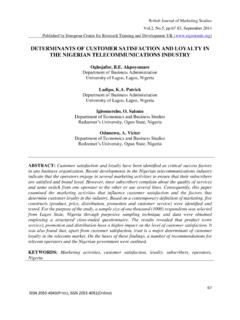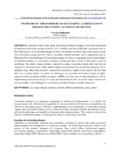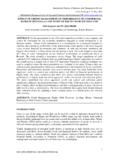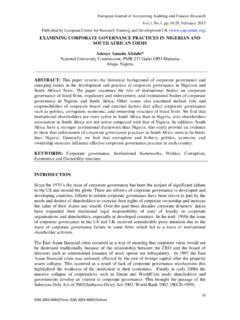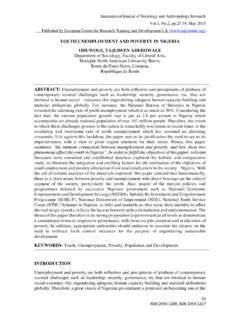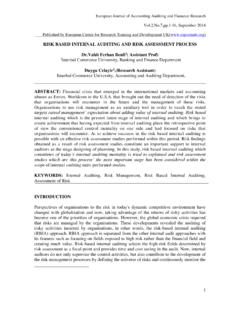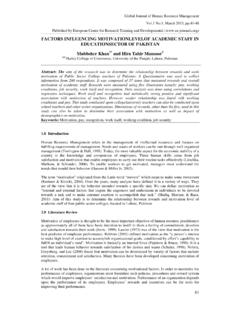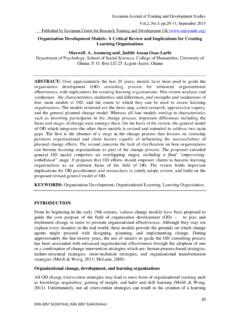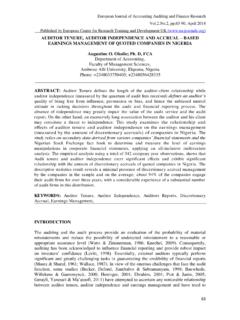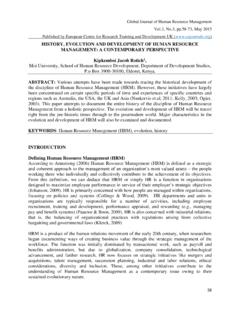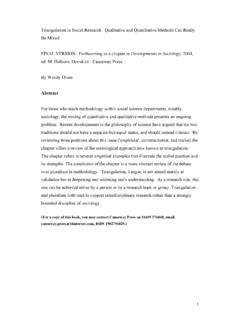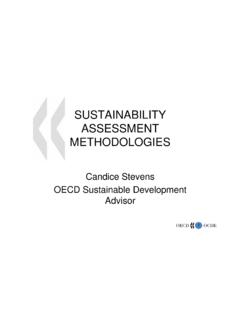Transcription of MIXED METHODS- THEORY AND PRACTICE. SEQUENTIAL ...
1 International Journal of quantitative and qualitative Research Methods , , , May 2017 ___Published by European Centre for Research Training and Development UK ( ) 10 ISSN 2056-3620(Print), ISSN 2056-3639(Online) MIXED METHODS- THEORY AND PRACTICE. SEQUENTIAL , EXPLANATORY APPROACH Phillip Bowen1, Richard Rose2, Andrew Pilkington2 1 Faculty of Business and Law, University of Northampton, UK 2 Faculty of Education and Humanities, University of Northampton, UK ABSTRACT: There appears to be a paucity of research undertaken in emotional intelligence in higher education suggesting a gap in which research can be undertaken that can provide new insight and add together with knowledge and understanding.
2 This article discusses a study using SEQUENTIAL , explanatory, MIXED methodology, which was undertaken on a sample of 533 academics (those employed by a university full time, part time, and hourly and who may be lecturers, tutors, instructors, researchers). The reason for collecting SEQUENTIAL quantitative and qualitative data into one study brings together two types of information providing greater understanding and insight into the research topics that may not have been obtained analysing and evaluating data separately. The findings from interviews helps explain the findings from quantitative data.
3 KEYWORDS: MIXED Methodology, SEQUENTIAL , Explanatory. INTRODUCTION Background and justification There is a paucity of research undertaken in emotional intelligence in higher education (Briner, 1999; Woods, 2010). There is, therefore, a gap in which research can be undertaken. A MIXED mythological study using a SEQUENTIAL , explanatory approach has been undertaken of a survey sample of 533 academics from universities (Bowen, Pilkington and Rose, 2016). Interviews were also undertaken (Bowen, Rose and Pilkington, 2016). The findings from the interviews) provide greater depth and understanding as to how the academic feels (Gratton and Jones, 2010).
4 The findings from the interviews also helps explain the findings from the quantitative data. The main finding suggests that there is an inverse relationship between emotional intelligence and perceived stress; the higher the emotional intelligence- the lower the perceived stress the academic experiences. (Bowen, Pilkington and Rose, 2016) The purpose of this article explains the process of undertaking SEQUENTIAL , explanatory, MIXED methodology undertaken in this study. This article also contributes to the existing literature, with the desire of encouraging researchers to continue to undertake studies associated with MIXED methodology.
5 It also adds to existing research, informing those undertaking future research the value associated with using the MIXED methods approach. Researchers undertaking MIXED methodology have in recent decades described it as hybrid, combined, and multi-method (Creswell and Plano Clark, 2011). However, there appears to be no single exhaustive list of MIXED method designs (Johnson and Onwuegbuzie, 2004). MIXED methodology may not include both quantitative and qualitative methods (Morse and Niehaus, 2016). However, it is described as quantitative and/ or qualitative data combined within a single study complementing each other by integrating their strengths (Green and Caracelli, 1997; International Journal of quantitative and qualitative Research Methods , , , May 2017 ___Published by European Centre for Research Training and Development UK ( ) 11 ISSN 2056-3620(Print), ISSN 2056-3639(Online) Tashakkori and Teddlie, 2003).
6 The approach, to the order of collection of data, may also vary, where quantitative and/or qualitative phases may be concurrent or SEQUENTIAL (Creswell, Fetters and Ivankova, 2004). MIXED methodology is the corner stone of research within social science that is experienced within everyday life (Creswell and Plano Clark, 2011; Johnson and Onwuegbuzie, 2004). MIXED methodology is described as being the third paradigm (Johnson and Onwuegbuzie, 2004:15); a third methodological movement (Teddlie and Tashakkori, 2009:1); and includes two (or more, or both) quantitative and/or qualitative approaches (Morse and Niehaus (2016).)
7 It no longer restricts the researcher to particular paradigms that have been traditionally the case and is considered a legitimate means of undertaking research in social and human science (Creswell and Plano Clark, 2011). quantitative and qualitative approaches to research can be used with any paradigm (Guba and Lincoln, 1994), linking the purpose (research questions) with procedures (research methods) (Morgan, 2014). Using MIXED methodology can help blend different approaches allowing the researcher to design research questions within the context and parameters of their study (Johnson and Onwuegbuzie, 2004).
8 Bernard (2014) adds that MIXED methodology has led to an explosion of collaborative and creative research across disciplines. It helps to address broader questions providing a more expansive and creative approach to research (Johnson and Onwuegbuzie, 2004). The MIXED methods approach includes a multiple level strategy incorporating a two phase approach where (for example) quantitative research is undertaken first, followed by qualitative research; a systematic and planned approach to research (Creswell, 1995; Flick, 2011). Each phase can then be triangulated into a third phase where quantitative data can provide general patterns and width and, qualitative data reflects upon experience and depth (Newby, 2014).
9 The findings from the qualitative data can also help contextualises and enrich findings (Bryman, 2004, Mason 2006), increase validity when interpreting the data (Bazeley, 2002; Orgard, 2005), and generate new knowledge (Stange, 2006). Using MIXED methodology can help understand the topic area in greater depth (Hoover and Krishnamurti, 2010). It can help increase confidence in findings, providing more evidence while offsetting possible shortcomings from using a single approach (Albert, Trochelman, Meyer and Nutter, 2009; Bryman, 2004; Caruth, 2013; Creswell and Plano Clark, 2011; Tashakkori and Creswell, 2008).
10 Whereas undertaking research using MIXED methodology can be time consuming it can help to address broader questions adding insight that could have otherwise have been missed (Creswell and Plano Clark, 2011). Tashakkori and Teddlie (2003) identify around forty MIXED methodologies. Of these, the SEQUENTIAL , explanatory, MIXED methodology is regarded as a popular approach to undertaking research, but not easy to implement (Ivankova, Creswell and Stick, 2016). There are two main categories that emerge: a) MIXED method design- that mixes the methods and; b) MIXED model design- that mixes the different stages of the research (Tashakkori and Teddlie, 2003).
